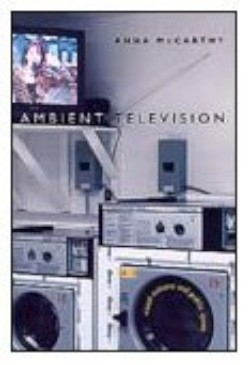Ambient Television
Visual Culture and Public Space
People do not like to be alone. Although they may claim to desire privacy, in reality most need the comfort of having someone—or something—close by for company. That’s the reason that television is so omnipresent, theorizes McCarthy in this treatise on how the medium is used outside the home.
In the days when there were more houses without television than with, watching the tube was a reason for a social gathering, maybe at a relative’s or a neighbor’s place, but also at taverns or similar locales. This changed the dynamic of the “host” business. How does the owner accommodate those who wish for the relative peace and quiet they had come to expect, versus the desires of the new clientele to experience the miracle of the new medium?
It didn’t take long for businesses and advertisers to become aware of television’s potential for sales, not only from commercials, but at the stores themselves. In-store video demonstrations (“point of purchase”) could increase impulse purchasing. Physical placement of TV units became one of myriad foci of scientific study. Where is the monitor most likely to catch the eye of passersby and “invite” them inside for a closer look? McCarthy’s references makes one wonder if those who make these decisions really give much thought to the psychology behind them.
Another public use for television, often considered an electronic babysitter, has been to “shorten perceived waiting time” at establishments ranging from supermarket checkouts to airports where it is used “to entertain, to alleviate boredom, to reduce stress caused by delays and travel hassles.” Not that waiting is necessarily a bad thing: “In places like theme parks, where lines for rides can last over an hour, the very existence of a queue can generate revenue, providing the kind of captive audience for television advertising that is highly valued in the economy of the place-based media industry.”
McCarthy, an assistant professor of Cinema Studies at the Tisch School of the Arts at New York University, takes a scientific approach to a medium that has been accused of catering to the lowest common denominator. Whether or not television is worth the effort is for the reader to decide.
Reviewed by
Ron Kaplan
Disclosure: This article is not an endorsement, but a review. The publisher of this book provided free copies of the book to have their book reviewed by a professional reviewer. No fee was paid by the publisher for this review. Foreword Reviews only recommends books that we love. Foreword Magazine, Inc. is disclosing this in accordance with the Federal Trade Commission’s 16 CFR, Part 255.

